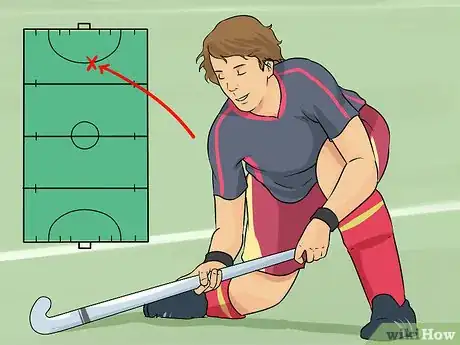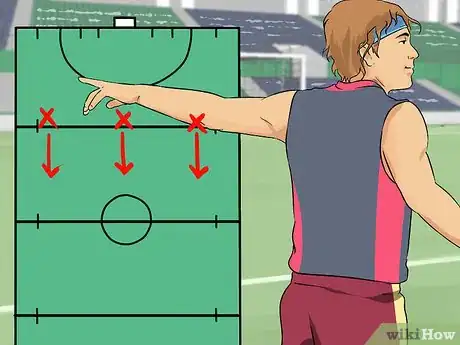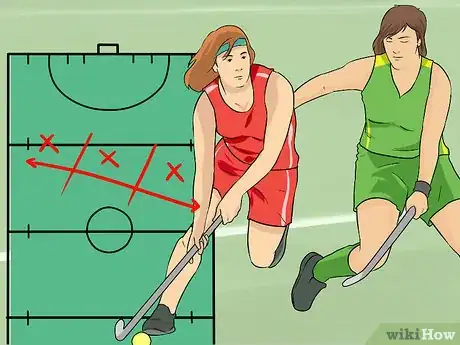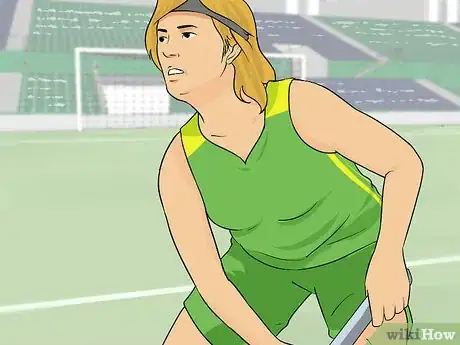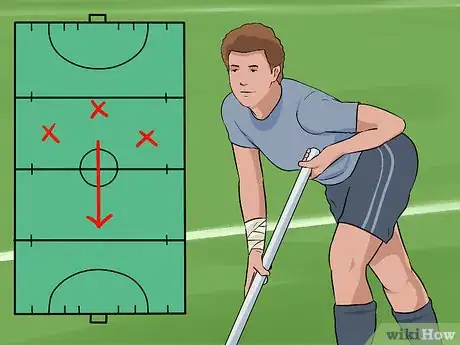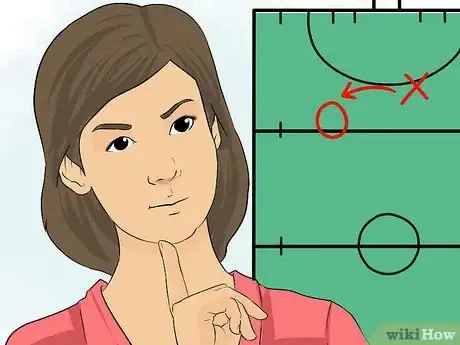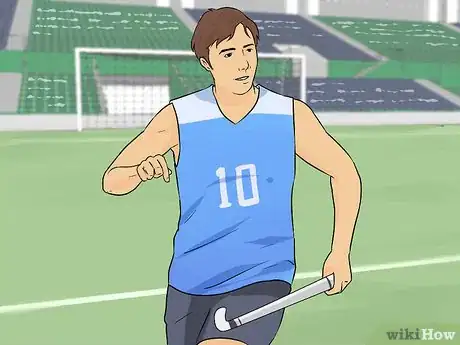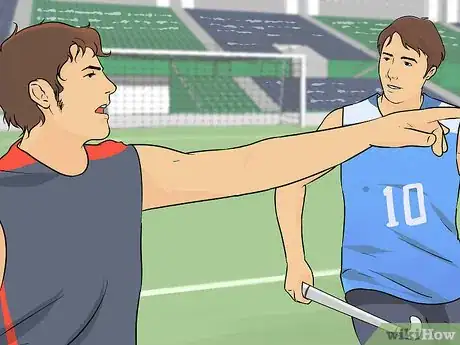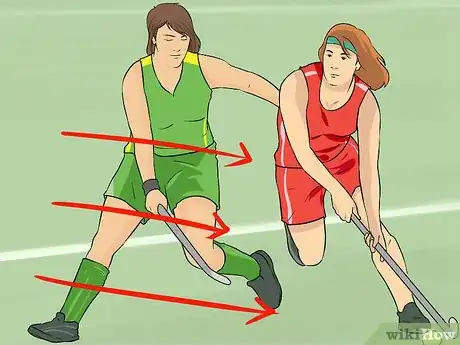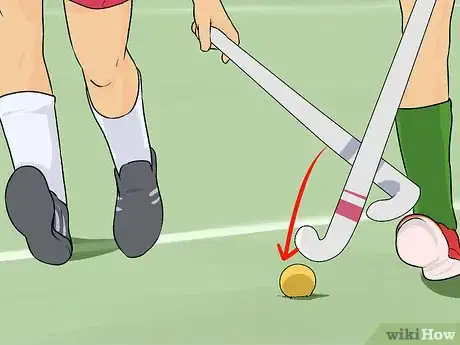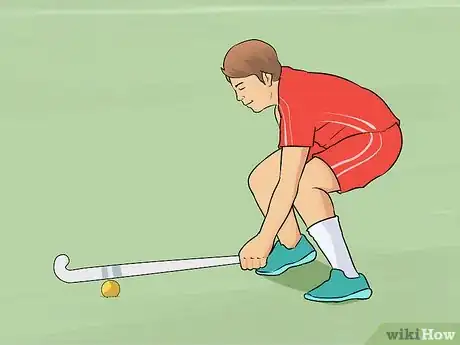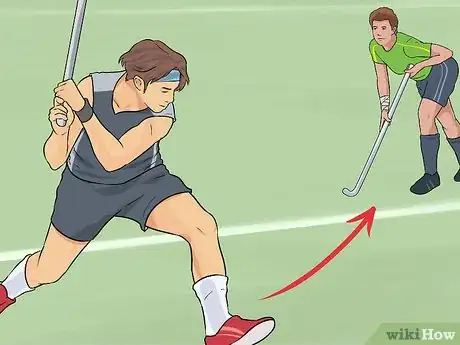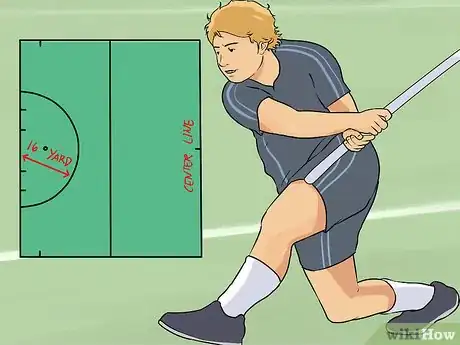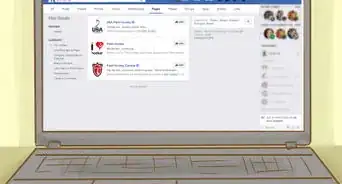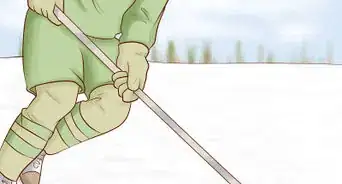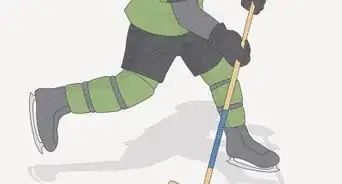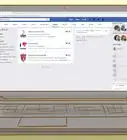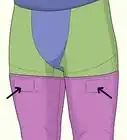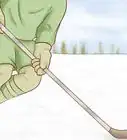This article was co-authored by wikiHow Staff. Our trained team of editors and researchers validate articles for accuracy and comprehensiveness. wikiHow's Content Management Team carefully monitors the work from our editorial staff to ensure that each article is backed by trusted research and meets our high quality standards.
This article has been viewed 43,601 times.
Learn more...
As the last line of defense before the goalkeeper, center back is one of the most important positions in field hockey. Protecting your goal is the number one priority, and the best way to do this is to position yourself correctly, mark dangerous players, and put pressure on the opponent with the ball. The center back position benefits from having a complete view of the game and their teammates in front of them and therefore should be an excellent communicator to keep their team working as a unit. Being a great center back does not just mean playing strong defense - it also involves passing and distributing the ball to your midfielders and forwards up the field to generate offensive plays.
Steps
Positioning Yourself on the Field
-
1Place yourself on the line-to-goal. That is, if you were to draw a straight line from where the ball is on the field to where the goal is that you are defending, you should be positioned right on that line. This prevents the other team from hitting the ball straight down the field toward the goal. Ensure that your back is aligned with your goal.
- Protecting the goal and the center of the field is your first priority. You want to force them to play the ball on the sides of the field, where it's less dangerous.
-
2Don't get too spread out from your midfield line. When your team has the ball higher up the field (i.e. near the goal you are trying to score on), don't get stuck too far back. Keep pushing up to support the midfielders and forwards.
- When the other team regains possession, start backpedaling to retreat toward your own goal. Running backwards allows you to keep your eye on the ball at all times.
- Make sure you also don't push too far up in case the other team has a counterattack and you have to sprint back down the entire length of the field. You should never be much farther than the 50 yard line.
Advertisement -
3Adjust your position (along with the rest of the defensive line) using the teeter-totter method. The center back, right back, and left back should be readjusting as a unit according to where the ball is moving on the field. They should staggered on a diagonal line so as to not be caught in a flat line and risk being beat simultaneously.
- For example, when an opponent is dribbling down the field on your right side, the right defender (closest to the ball) will step up to put pressure on that player. The center defender will remain in the center of the field but will be a few steps behind the line of the right defender. The left defender (furthest from the ball) will be staggered even further behind the center defender.
- If the ball moves from one side to the other, the whole defensive line moves like a teeter totter. This allows for the other two defenders behind to be back-up support in case the first defender gets beat.
-
4Always be ready on defense. Even if the action is far away and you feel like you have nothing to do defensively, you should always be checked into the game and adjusting your position, both laterally and vertically. That way, if something unexpected happens and the other team has a counterattack, you are already in position and ready to defend.
-
5Maintain a “bowl” shape with your other defenders when your team has the ball. You should be the closest to the goal you are defending (or the “deepest” on the field), with your left and right defenders at about 45 degree angles on either side of you.
- This allows you to pass to them easily and move the ball up the field along the sidelines.
- When your side defenders have the ball, you being on a slightly backwards angle helps them to safely pass back to you and away from danger in case they can't go forward.
Marking
-
1Know your marking strategy. Marking helps protect your defensive zone of the field by covering space or opposing players to keeping them from scoring. The two main types of marking techniques are zone and man-to-man, and many teams use a mix of both depending on the situation.
- Zone marking means a player is responsible for the space around them. For example, the right back is responsible for the back right corner of the field. Any opposing player who enters that space is their responsibility. This marking strategy is best when gameplay is spread out and opponents are interchanging positions, so that you can simply “switch” marks with your teammates instead of chasing them down the field.
- Man-to-man marking means each player chooses an opponent to mark and always sticks with them, no matter where they go on the field. A useful trick is to memorize the number on your mark's jersey so that you never lose her. This marking strategy is best when gameplay is past-paced and confined near the goal you are defending because it limits confusion on who is marking whom amidst potential chaos. Every single opponent who enters your defensive circle surrounding the goal should be closely marked at all times.
- Marking is not just for defenders. Make it clear to your team (especially the midfielders) that they should be helping out with marking as well. Even your forwards should be sprinting back during a counterattack.
-
2Place yourself on the correct side of your mark according to the situation. Sometimes it is best to step in front of your mark to block her from receiving a pass and intercept it yourself. Other times it is better to stay close behind your mark (in between her and the goal) so that even if she receives the ball she cannot go straight to goal.
- Deciding the best way to position yourself while marking should come naturally as you assess each scenario. When in doubt, ask your coach for advice.
-
3Communicate to your teammates about who they should be marking. Since you can see what is happening on the entire field front of you, your role as a center back is to make sure all “dangerous” attacking players on the opposing team are marked.
- In a clear, loud voice, direct your teammates in front of you on where to position themselves and tell them to mark up if they are not doing so already.
- You can say something like, “Hey Sarah, mark #5!” or give them more directional instructions like, “Watch #13 behind your left shoulder!” to give them an idea of where their marks are.
Getting the Ball from an Opposing Player
-
1Force or channel them to one side of the field. An important defensive principle in field hockey is to minimize the opposing player's space by guiding them away from your goal and the center of the field. When someone is dribbling toward you, always force them toward the sidelines.
- Since you are the center back, you have an option of which side you want to force them to. It is better to force them to your right side because that is your “strong side” of your stick. Note the left side players do not want to take this approach and instead want to force them to their left side, toward the sideline.
- Position your body slightly to the left so that your shoulders are open toward the right. “Invite” them to dribble toward your strong side. Use the sideline or another defender to help you trap them into a small space.
- If you are running neck-and-neck with your opponent who is dribbling the ball, keep forcing her to one side. This is called shadowing her down the field. Try as hard as you can to keep running at the same speed as her and keep her from cutting you off. One of your other teammates will likely come to your help and you can double-team her together.
-
2Jab at the ball. Jabbing is when you quickly poke at the ball with your stick when your opponent is dribbling to make them mess up or lose the ball.
- Be sure you are not too close to your opponent. Position yourself about a stick-length away from her.
- Reposition your grip on the stick as if you were holding a frying pan with your left hand. In one fluid motion, release your right hand from the stick and extend your left arm (holding to stick) while simultaneously lunging toward the ball so that the toe of your stick hits the ball.
- Quickly retrieve your stick with both hands. A jab only lasts a second or two - don't let your stick linger near the ball. You can perform a few quick jabs in a row if you weren't successful the first time.
- The point of jabbing is not necessarily to gain possession of the ball, but to distract and mess up the player with the ball in order to set yourself up for a more successful tackle.
-
3Tackle to get the ball from your opponent. Now that you've distracted or messed up your opponents with a few jabs, you are ready to lay down a tackle.
- The best way to tackle is to lie your stick flat on the ground on your right side, crouching down so that you are in a strong, athletic stance. Keep your hands far apart on your stick for stability.
- Collect the ball on your stick and push through until you have regained possession. Be sure not to “hack” or continuously swing/hit at the ball with your stick. This will be a foul called against you.
- Do not dive into tackles, as it makes it easier for the opposition to beat you. Time your tackles only when you know you have a good chance of coming up with the ball, once you have already put significant pressure on your opponent. Do not tackle if your opponent is coming towards you with a lot of speed and space.
-
4Double-team your opponent. Of course, the best defense is team defense. You and another teammate can work together so that one person is putting pressure and forcing the opponent toward a space where the other person is waiting there to tackle.
- Communication is key when double-teaming. If you are the tackler, guide your teammate ahead of you on where they should force the opponent by saying things like “Stay with her, force her right!”
Initiating Offensive Plays as a Defender
-
1Clear the ball out to the sides when you come up with it. If you make a tackle and regain possession of the ball, avoid passing the ball down the middle of the field. This can be very dangerous, because if they are intercepted, it could lead to a fast counterattack.
- If your left and right defenders are correctly positioned, they should be ready to receive the ball from you on the sidelines. You may even have a side midfielder open further up the field to pass to.
- If you cannot find a sideline teammate to pass to and you find yourself under a lot of pressure, hit the ball over the sideline anyways. This is the safest option. Even though it will be the other team's free hit, at least it will buy your team time to set up to defend.
- The only time you should hit the ball up the center of the field is if you have a wide open channel and an open teammate to pass to, with no risk of your pass being intercepted.
- Never intentionally hit the ball over your back endline. This will be called as a foul against you, resulting in a short corner, a set play in which the offensive team has a very strong chance of scoring.
-
2Pass more than you dribble. As a center defender, your role is to be a distributor, not a dribbler. Never go sprinting up the field with the ball, because if you get it taken away you leave your team in trouble by being out of position on defense.
- Make sure your passes are hard so that they go fast and far up the field. You want to clear it as far as you can away from your defensive zone. Also make sure they are flat to the ground, as high balls will be called as a foul.
-
3Take 16 yard hits. As the center back, you will usually taking free hits at the top of the circle (16 yards from the endline) after the ball has gone over the endline off of the stick of an opposing player. This is like the equivalent of a “goal kick” in soccer.[1]
- 16 yard hits are a new opportunity to generate offensive plays from the back. Pass the ball mainly to your side defenders on the left and right of you using a hit, sweep, or a strong push. Then they can send it up the field.
- Occasionally, you can feed the ball up to your midfielders, and on rare occasions, you may be able to pass the ball all the way up to your forwards using a strong hit or aerial (a very high pass in the air). Be cautious, however, and only use these longer passes when your teammates are wide open.
-
4Be the pivot player on transfers. Sometimes when you watch high-level field hockey, you will notice the ball being passed across from the left back to the center back to the right back, or vice versa. This is called a transfer because the ball is being transferred from one side of the field to another. As the deepest player on this transfer, you are the “pivot” player.
- Transfers can happen just once or multiple times in a row. One transfer from the left to right, for example, gives your team a chance to attack from a different angle. Multiple transfers in a row allow your teammates upfield time to reset and find open spaces, and also tire out the opposing team's forwards.
- Keep passing the ball across to the other side using a strong hit or push. If you receive it from your right back, you will likely turn your body and pass it over to your left back.
- Once your teammates up the field become open, only then should you or your other defenders hit it up to them. When transferring the ball, patience is key.
Community Q&A
-
QuestionCan you score a goal if you play center back?
 Community AnswerYes, it is possible. While it is unlikely that you will score during normal gameplay since you are always the furthest from your attacking goal, you can be the designated "hitter" on a short corner and score that way.
Community AnswerYes, it is possible. While it is unlikely that you will score during normal gameplay since you are always the furthest from your attacking goal, you can be the designated "hitter" on a short corner and score that way.
